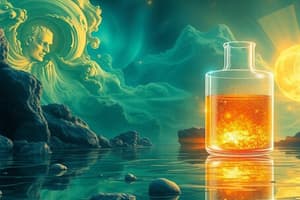Podcast
Questions and Answers
What effect does increasing pressure have on a gaseous equilibrium system?
What effect does increasing pressure have on a gaseous equilibrium system?
- It shifts the equilibrium towards the side with more moles of gas.
- It always shifts the equilibrium to the reactants' side.
- It shifts the equilibrium towards the side with fewer moles of gas. (correct)
- It has no effect on the position of equilibrium.
In which scenario would you expect a reaction to go to completion?
In which scenario would you expect a reaction to go to completion?
- The products are more stable than the reactants. (correct)
- There is no formation of gas or precipitate.
- The reactants are in low concentrations.
- The reaction is reversible and can shift back.
What does a positive enthalpy change (ΔH > 0) indicate about a reaction?
What does a positive enthalpy change (ΔH > 0) indicate about a reaction?
- The reaction releases heat to the surroundings.
- The reaction absorbs heat from the surroundings. (correct)
- The reaction is irreversible.
- The reaction occurs spontaneously.
How does decreasing the concentration of products affect equilibrium?
How does decreasing the concentration of products affect equilibrium?
What is the significance of standard enthalpy of formation (ΔH°f)?
What is the significance of standard enthalpy of formation (ΔH°f)?
Which statement accurately describes Le Châtelier's Principle?
Which statement accurately describes Le Châtelier's Principle?
What is the effect of increasing the temperature for an endothermic reaction?
What is the effect of increasing the temperature for an endothermic reaction?
What does the standard state of a substance refer to?
What does the standard state of a substance refer to?
How do the standard enthalpy changes help in chemical thermodynamics?
How do the standard enthalpy changes help in chemical thermodynamics?
Flashcards are hidden until you start studying
Study Notes
What Determines the Position of Equilibrium?
- Le Châtelier's Principle: If a system at equilibrium is disturbed, it shifts to counteract the disturbance.
- Concentration Changes: Adding or removing reactants/products shifts the equilibrium towards the side with less concentration.
- Temperature Changes:
- For endothermic reactions, increasing temperature shifts right (to products).
- For exothermic reactions, increasing temperature shifts left (to reactants).
- Pressure Changes:
- Increasing pressure shifts to the side with fewer moles of gas.
- Decreasing pressure shifts to the side with more moles of gas.
Why Do Some Reactions Go to Completion?
- Strong Reaction Driving Forces:
- Reactions can go to completion if products are significantly more stable or favored than reactants.
- Formation of a gas, precipitate, or water can drive a reaction to completion.
- Concentration: High concentrations of reactants increase the likelihood of reaching completion.
- Irreversible Reactions: Some reactions are inherently irreversible due to the nature of bonding or reaction mechanisms.
Clearly Understand the Heats of Reaction
- Enthalpy Change (ΔH):
- The heat absorbed or released during a reaction at constant pressure.
- Endothermic (ΔH > 0): Heat absorbed.
- Exothermic (ΔH < 0): Heat released.
- Standard Enthalpy of Formation (ΔH°f):
- The heat change accompanying the formation of 1 mole of a compound from its elements in their standard states.
- Reaction Enthalpy Calculation:
- ΔH° = ΣΔH°f (products) - ΣΔH°f (reactants).
Understand the Standard State of Reactions and Standard Enthalpies
- Standard State:
- The physical state of a substance under standard conditions (1 atm pressure and 25°C or 298 K).
- Standard Enthalpy (ΔH°):
- Refers to enthalpy changes measured under standard conditions.
- Importance of Standard States:
- Provides a reference point for comparing thermodynamic properties.
- Helps in calculating energy changes in chemical reactions accurately.
- Standard Entropy (S°):
- The measure of disorder in a system at standard conditions, influencing reaction spontaneity.
Le Châtelier's Principle
- Equilibrium shifts to counteract disturbances.
- Adding reactants shifts to the right (products).
- Adding products shifts to the left (reactants).
- Increasing temperature shifts to the right for endothermic reactions.
- Increasing temperature shifts to the left for exothermic reactions.
- Increasing pressure shifts to the side with fewer moles of gas.
- Decreasing pressure shifts to the side with more moles of gas.
Why Reactions Go to Completion
- Product stability drives completion.
- Gas formation, precipitate formation, or water formation are strong driving forces.
- Higher reactant concentrations increase completion likelihood.
- Some reactions are inherently irreversible.
Heats of Reaction
- Enthalpy change (ΔH) represents heat absorbed or released at constant pressure.
- Endothermic reactions (ΔH > 0) absorb heat.
- Exothermic reactions (ΔH < 0) release heat.
- Standard enthalpy of formation (ΔH°f) is the heat change when 1 mole of a compound forms from its elements in their standard states.
- Reaction enthalpy (ΔH°) is calculated as: ΔH° = ΣΔH°f (products) - ΣΔH°f (reactants).
Standard State and Standard Enthalpies
- Standard state refers to 1 atm pressure and 25°C (298 K).
- Standard enthalpy (ΔH°) is enthalpy change under standard conditions.
- Standard states provide a reference point for comparing thermodynamic properties.
- Standard entropy (S°) measures the disorder in a system at standard conditions, influencing reaction spontaneity.
Studying That Suits You
Use AI to generate personalized quizzes and flashcards to suit your learning preferences.




